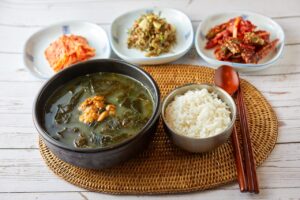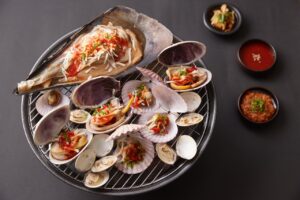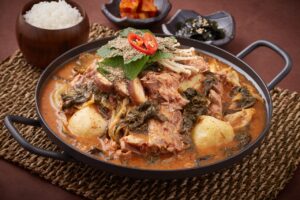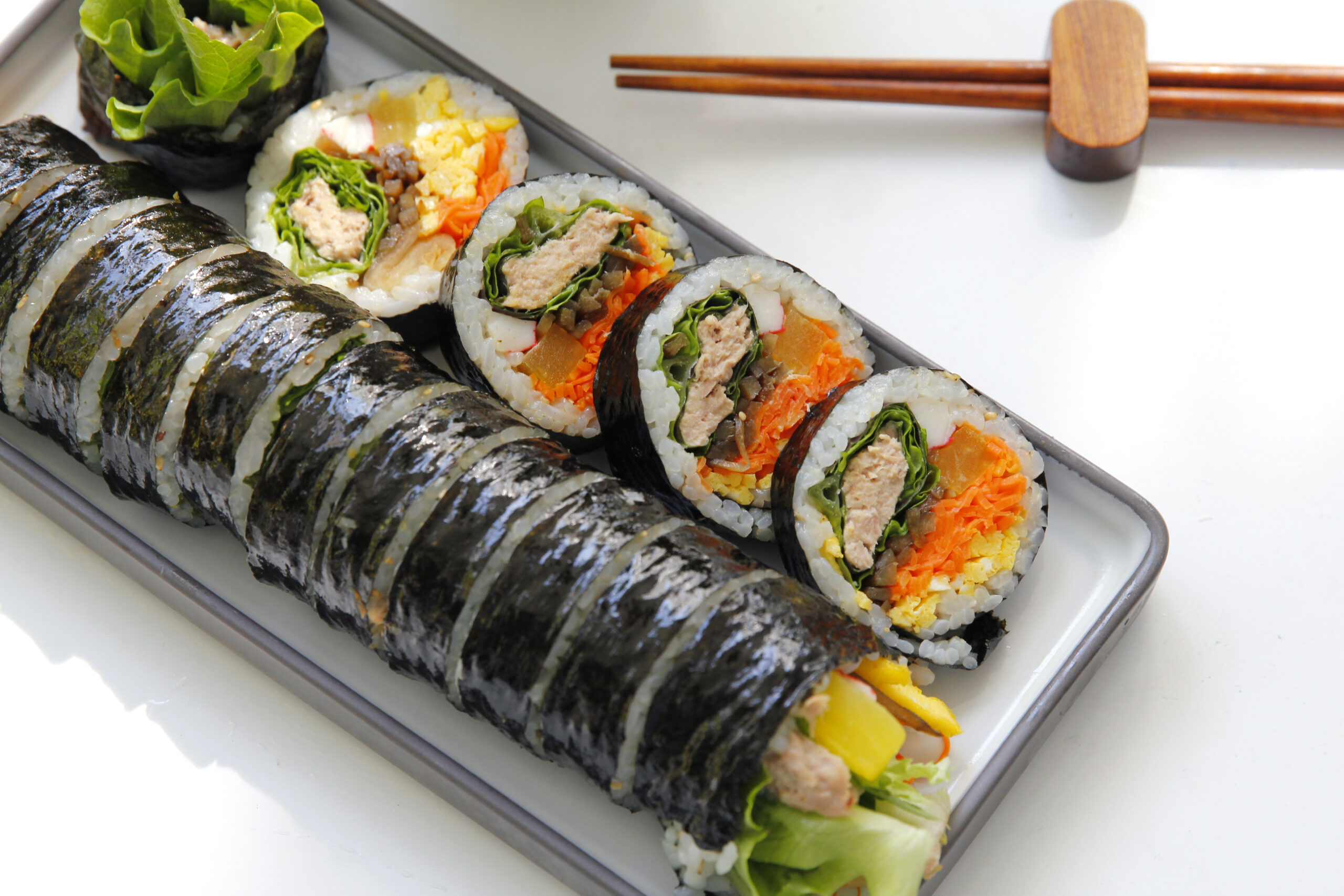
Gimbap
Koreans love gimbap for several reasons, ranging from its convenience as a portable meal to its delicious and balanced flavors. Gimbap is a versatile and iconic dish in Korean cuisine that has become a beloved staple for people of all ages. Here are some reasons why Koreans have a deep affection for gimbap:
- Portability: It is a convenient and portable food option. Its tightly rolled and compact form makes it easy to carry and enjoy on the go, whether you’re traveling, working, or studying.
- Variety: It offers a wide variety of fillings and ingredients. From vegetables to meat, eggs, and even seafood, there are endless combinations to suit different tastes and preferences. This diversity makes it appealing to a broad range of people.
- Balanced Nutrition: It is often made with a combination of ingredients that provide a balanced mix of carbohydrates, proteins, and vegetables. It’s a complete meal that offers sustenance and energy, making it a popular choice for lunch or as a snack.
- Nostalgia: It is a comfort food for many Koreans, reminding them of childhood memories, family gatherings, and special occasions. It’s a dish that carries a sense of familiarity and warmth.
- Cultural Significance: It is deeply ingrained in Korean culture and culinary tradition. It’s commonly enjoyed as part of picnics, school lunches, and casual gatherings. Its presence in various aspects of Korean life contributes to its popularity.
- Affordability: It is often an affordable option compared to other meals, making it accessible to a wide range of people, including students and those looking for budget-friendly dining choices.
- Taste and Texture: The combination of seasoned rice, fillings, and seaweed creates a delightful balance of flavors and textures. The crunch of fresh vegetables, the tenderness of meat, and the umami of seaweed make each bite satisfying.
- Customization: It can be customized to suit individual preferences. Whether you prefer vegetarian options or meat-filled varieties, you can create it roll that aligns with your taste.
- Social Aspect: Sharing and enjoying gimbap with family, friends, and colleagues enhances the social experience. It’s a dish that fosters a sense of togetherness and community.
Overall, gimbap’s blend of convenience, taste, variety, and cultural significance contributes to its popularity among Koreans. It’s a dish that transcends generations and occasions, making it a beloved and enduring part of Korean culinary culture.
The Meaning of words.
“Gimbap” (김밥) is a Korean word that combines two components:
- “Gim” (김): This refers to the roasted seaweed sheets, also known as nori, that are used to wrap the fillings in the roll. Seaweed is a fundamental ingredient in gimbap, providing flavor, texture, and holding the roll together.
- “Bap” (밥): This translates to “rice” in Korean. Rice is a staple food in Korean cuisine, and in gimbap, it serves as the base and filling for the roll.
So, when you put the two components together, “Gimbap” essentially means “seaweed rice roll” or “rice and seaweed roll.” This name accurately describes the main elements of the dish: the rice and various fillings rolled in seaweed sheets.
How to make it?
Cooking Method
Gimbap (김밥) is a popular Korean dish that consists of seaweed (kim) rolls filled with a variety of ingredients. It is often compared to sushi rolls, but there are some differences in terms of ingredients and preparation. it is a versatile dish that can be customized with a range of fillings, making it a favorite among Koreans as a convenient and tasty snack or light meal.
Here’s a breakdown of the components and preparation of :
Ingredients:
- Sheets of roasted seaweed (nori)
- Steamed white rice seasoned with sesame oil and salt
- Various fillings (examples include cooked and seasoned vegetables, pickled radish, eggs, imitation crab sticks, ham, and more)
- Optional: sesame seeds
Instructions:
- Prepare the Fillings:
- Cook and prepare the ingredients you want to use as fillings. Common choices include blanched and seasoned vegetables, cooked and seasoned fish or meat, eggs, and pickled radish.
- Lay Out the Ingredients:
- Place a bamboo rolling mat (sushi mat) on a clean surface.
- Lay a sheet of roasted seaweed (nori) on the mat with the shiny side facing down.
- Spread Rice:
- Moisten your hands with water to prevent the rice from sticking.
- Take a handful of seasoned rice and spread it evenly over the seaweed, leaving about a 1-inch margin at the top.
- Add Fillings:
- Arrange the prepared fillings horizontally in the center of the rice.
- Roll the Gimbap:
- Start rolling the bamboo mat from the bottom, using gentle pressure to shape the ingredients into a compact cylinder.
- As you roll, make sure to press and tighten the roll to keep it firm.
- Seal the Roll:
- Moisten the top margin of the seaweed with a little water to help seal the roll.
- Cut and Serve:
- Once the roll is tightly wrapped, use a sharp knife to slice the roll into bite-sized pieces.
- Optionally, you can lightly brush the cut ends with a little sesame oil and sprinkle sesame seeds for extra flavor.
- Serve:
- it can be served as is, or you can pack it for a picnic or as a snack. It’s often accompanied by pickled radish and sometimes soy sauce or a dipping sauce.
Gimbap is loved for its convenience, portability, and the endless combinations of fillings you can use to create different flavors and textures. It’s commonly found in Korean markets, convenience stores, and even as a homemade treat.
Where can I eat Gimbap in Korea?
In Korea, you can find Gimbap at a variety of places, ranging from street food stalls to traditional restaurants. Here are some options where you can try Gimbap in Seoul:
- Gimbap Stalls and Street Food Markets: Walking around popular areas like Myeongdong, Insadong, or Namdaemun Market, you’ll likely come across street food stalls that sell it. These stalls offer a quick and affordable way to enjoy this delicious snack.
- Local Restaurants and Cafes: Many local Korean restaurants and cafes offer it on their menus. Look for smaller, traditional eateries that specialize in Korean cuisine, as they are more likely to serve authentic one.
- Gimbap Chains: There are also restaurant chains in Seoul that specialize one. Some well-known chains include “Kim Seon Saeng” and “Gimbap Cheonguk.” These chains offer a wide range of Gimbap options and other Korean dishes.
- Food Markets: Large food markets like Gwangjang Market and Tongin Market are known for offering a variety of traditional Korean foods, including it. These markets are great places to explore and sample various local dishes.
- Convenience Stores: It is a common convenience store snack in South Korea. You can find packaged Gimbap in major convenience store chains like GS25, CU, and 7-Eleven. While these may not be as fresh as those made on the spot, they’re still a convenient option.
- Department Store Food Courts: Many department stores in Seoul have extensive food courts that feature a wide range of Korean dishes, including it. This can be a good option if you’re looking for a more comfortable and air-conditioned dining environment.
Remember that it is a versatile dish, and the quality and variety can vary based on the location you choose. To find the best experience, consider asking locals for recommendations, checking online reviews, and exploring different areas of the city.
For Vegetarian and Vegan Korean Food
It can indeed be made to suit a vegetarian diet, but it depends on the ingredients used. Traditionally, Gimbap includes a variety of fillings, and while some of these may include meat or seafood, there are plenty of vegetarian-friendly options available as well. When ordering or making vegetarian one, you can choose or use ingredients like:
- Vegetables: Fillings such as blanched spinach, pickled radish (danmuji), carrots, cucumbers, bell peppers, and avocado can all be used to create a colorful and flavorful vegetarian one.
- Eggs: Scrambled eggs or thin omelette strips are a common ingredient in Gimbap and can provide a source of protein for vegetarians.
- Tofu: Sliced or marinated tofu can be a great addition to vegetarian Gimbap, offering both protein and texture.
- Kimchi: If you enjoy the spicy kick of kimchi, you can add this fermented vegetable to your Gimbap for extra flavor.
- Mushrooms: Sauteed or marinated mushrooms can add a savory element to your vegetarian Gimbap.
- Cheese: While not traditional, some variations of Gimbap include cheese as a filling for a unique twist.
When ordering Gimbap in a restaurant or purchasing it from a stall, you can inquire about the ingredients used to ensure that your choice is vegetarian. If you’re making Gimbap at home, feel free to experiment with your favorite vegetarian ingredients to create a roll that suits your taste preferences.
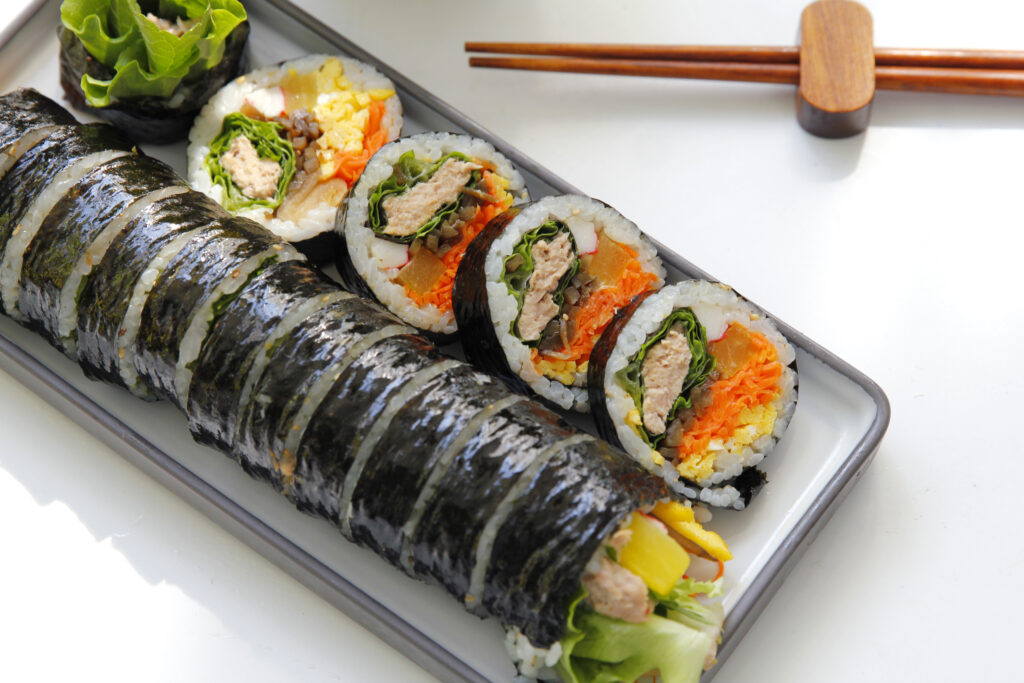
Joseon Gimbap in Seoul : 68, Yulgok-ro 3-gil, Jongno-gu, Seoul (서울특별시 종로구 율곡로3길 68)
About Jeonju Bibimbap (전주 비빔밥)

